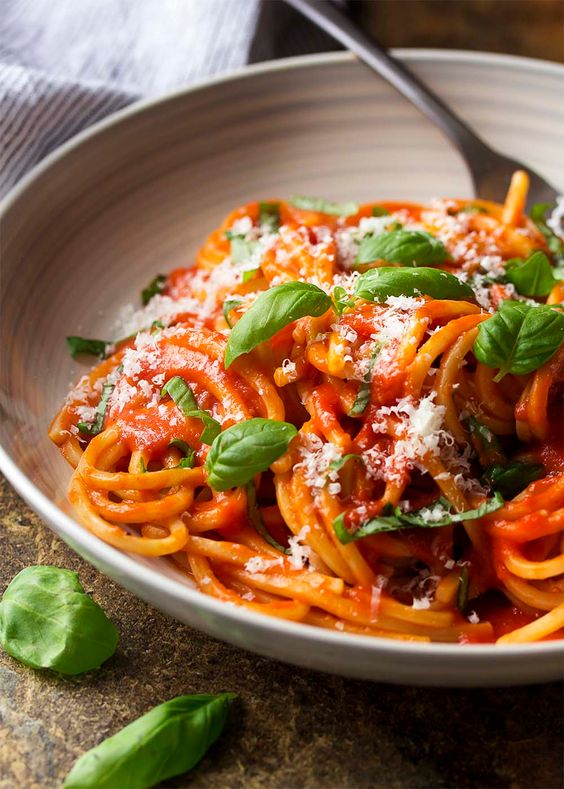Pomodoro sauce, a cornerstone of Italian cuisine, is a versatile and flavorful condiment that can elevate any dish. Whether you’re craving a classic spaghetti and meatballs or a vibrant grilled vegetable salad, a good pomodoro sauce is essential. In this exploration, we’ll delve into the world of authentic pomodoro sauce.

WHAT IS POMODORO SAUCE?
Pomodoro translates to “tomato” in Italian, making the term “pomodoro sauce” quite broad. However, authentic pomodoro sauce consists of five key ingredients: fresh tomatoes, extra-virgin olive oil, garlic cloves, basil, and salt. Onions are optional, and no spices are included.
What truly sets authentic pomodoro sauce apart is its use of fresh tomatoes, though some variations may use canned tomatoes. This sauce is typically paired with fresh homemade pasta or dried gnocchi and serves as a base for various Italian dishes. A dollop of fresh ricotta on top adds a delightful touch. The sauce can be prepared with either a rustic or smooth texture, depending on your preference.
WHY FRESH IS BEST
While canned tomatoes are undeniably convenient (and I often use them myself), opting for fresh tomatoes when they’re in season makes a significant difference. Fresh tomatoes bring a light and delicate flavor to the sauce, allowing it to truly taste like real tomatoes! The result is an incredibly refreshing sauce that isn’t heavy or overly acidic. Using fresh tomatoes will definitely earn you rave reviews!
INGREDIENTS
For the Pomodoro Sauce:
- 3 lb. (1.36 kg) fresh, ripe tomatoes
- 1 garlic clove, smashed
- 1/3 cup (50 g) finely minced shallots or onions
- 6 tbsp. olive oil
- 6–8 fresh basil leaves
- Salt
To Serve with Pasta:
- 1 lb. (450 g) dried penne or spaghetti (or fresh homemade pasta)
- 2 tbsp (30 g) unsalted butter (optional)
- Parmesan cheese
- Fresh basil leaves
NOTES & TIPS
Choosing Fresh Tomatoes:
Opt for San Marzano plum tomatoes, Roma tomatoes, or Beefsteak tomatoes from the farm stand. Cherry tomatoes are an option too, but their smaller size means more time spent blanching and peeling. Regardless, look for dark red, super sweet tomatoes for the best flavor.
Using Canned Tomatoes:
If you choose canned tomatoes, use 42 oz (1.2 kg) of whole, peeled plum tomatoes, preferably San Marzano. I recommend the Cento brand.
Onions vs. Shallots:
Onions are optional in pomodoro sauce. Personally, I often skip onions and use shallots instead, sometimes omitting garlic altogether. This is because I use this sauce as a base for many Italian-style dishes that don’t require garlic. If needed, I add a smashed garlic clove while reheating the base sauce to infuse the flavor beautifully. Shallots provide a balanced blend reminiscent of both onions and garlic.
Blanching Ahead:
You can blanch fresh tomatoes in advance and chill or freeze them for later use. This is especially helpful for making large batches of sauce when time is limited.
Butter:
While not traditional, I love adding butter to my pomodoro sauce, inspired by Marcella Hazan’s famous recipe featuring onions and butter. It adds a divine richness!
INSTRUCTIONS
Note: If using fresh tomatoes, blanch them first to remove the skins (instructions below). If using canned tomatoes, skip blanching, chop them into small pieces, and add them to the pan with their juice.
To Blanch Tomatoes:
- Bring a large pot of water to a boil.
- Cut a small X on the bottom of each tomato to make peeling easier.
- Blanch the tomatoes for 30 seconds to 1 minute.
- Using a slotted spoon, transfer them to a bowl. Do not drain the pot of water.
- Run cold water over the tomatoes to stop the cooking process. The skins should slip off easily.
- Slice the tomatoes in half and scoop out the seeds (doing this over a bowl helps catch the seeds). Dice the tomatoes into small pieces.
- The blanched, chopped tomatoes can be stored in the fridge for up to 4 days or frozen for up to 3 months.
Tip: Save the blanching water to cook the pasta or use it to water your plants or garden.
To Cook Pomodoro Sauce:
- In a large 12-inch (30 cm) skillet, warm the olive oil over medium heat.
- Sauté the onions or shallots (if using) until soft and translucent, about 5-7 minutes. Add the smashed garlic clove and cook until fragrant, about 30 seconds.
- Add the tomatoes to the pan and season with salt. Stir briefly with a wooden spoon.
- Bring to a gentle boil, then lower the heat and simmer until the sauce thickens slightly, about 15-20 minutes. The cooking time will depend on the juiciness of the tomatoes.
- Near the end of cooking, tear the fresh basil leaves into small pieces and stir them into the sauce.
- Remove the garlic clove. Purée the sauce using an immersion blender or a regular blender for a semi-rustic or smooth texture, or leave it unpuréed—it’s up to you! Taste and adjust the salt as needed.
To Serve with Pasta:
- Cook the pasta according to package instructions.
- While the pasta cooks, keep the pomodoro sauce simmering in a 12-inch pan (the pasta will finish cooking in the sauce).
- Once the pasta is al dente, use tongs or a small strainer to transfer it to the pan with the sauce. Add the butter if desired and stir well.
- Shave some Parmesan cheese over the pasta, toss to coat, and simmer for another 30 seconds.
- Transfer your delicious pasta al pomodoro to a large serving bowl and garnish with fresh basil on top. Enjoy!


